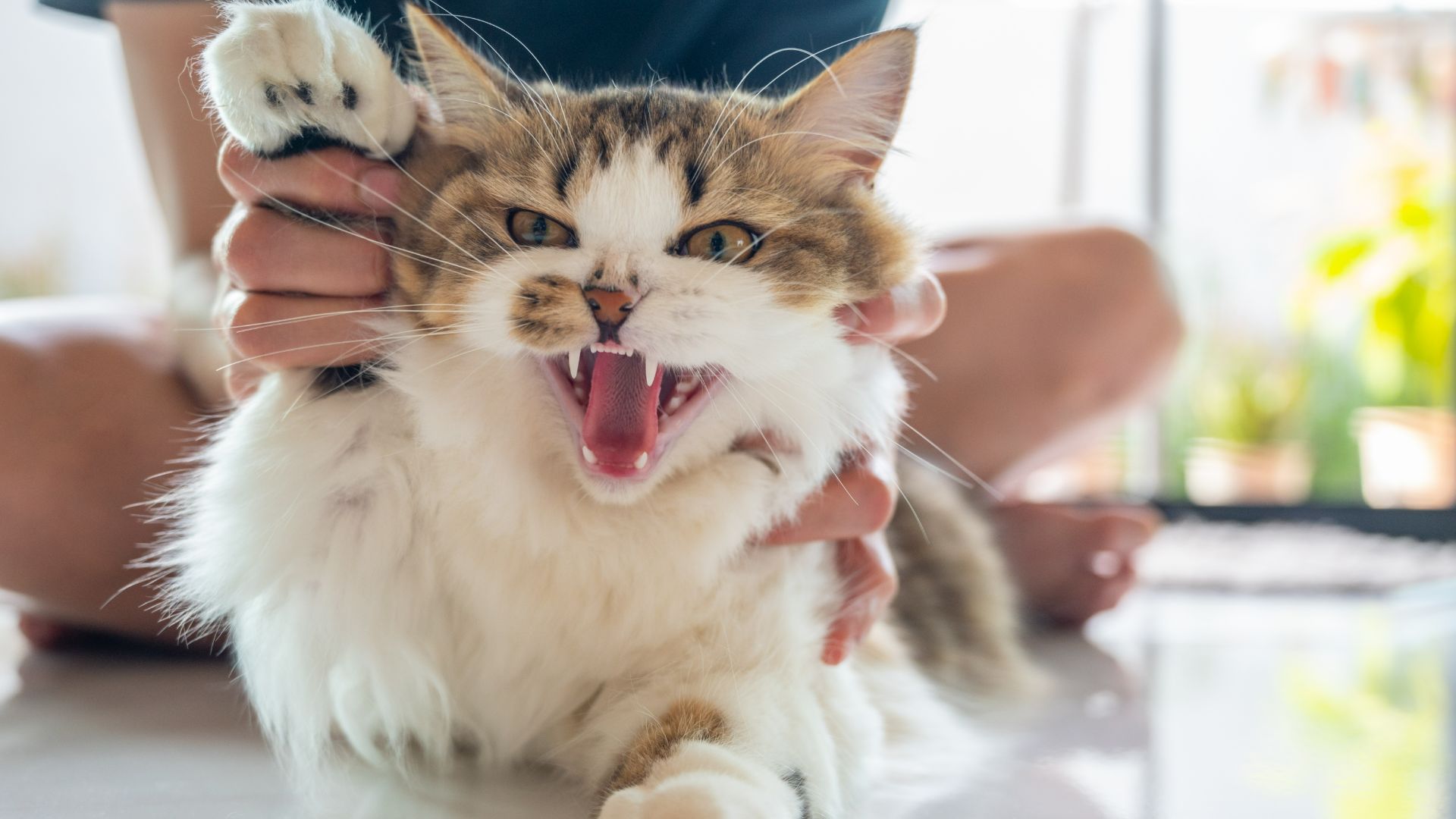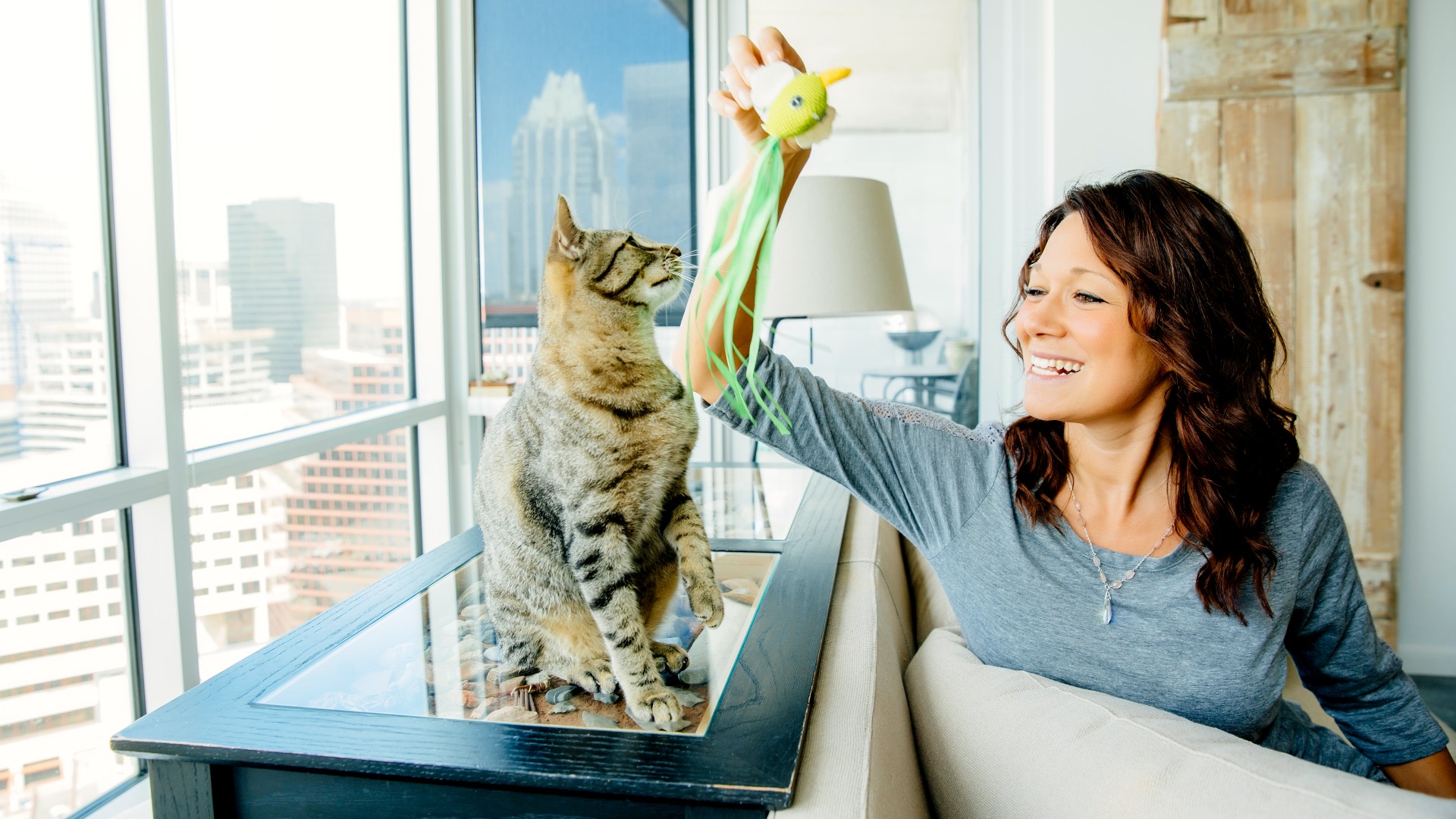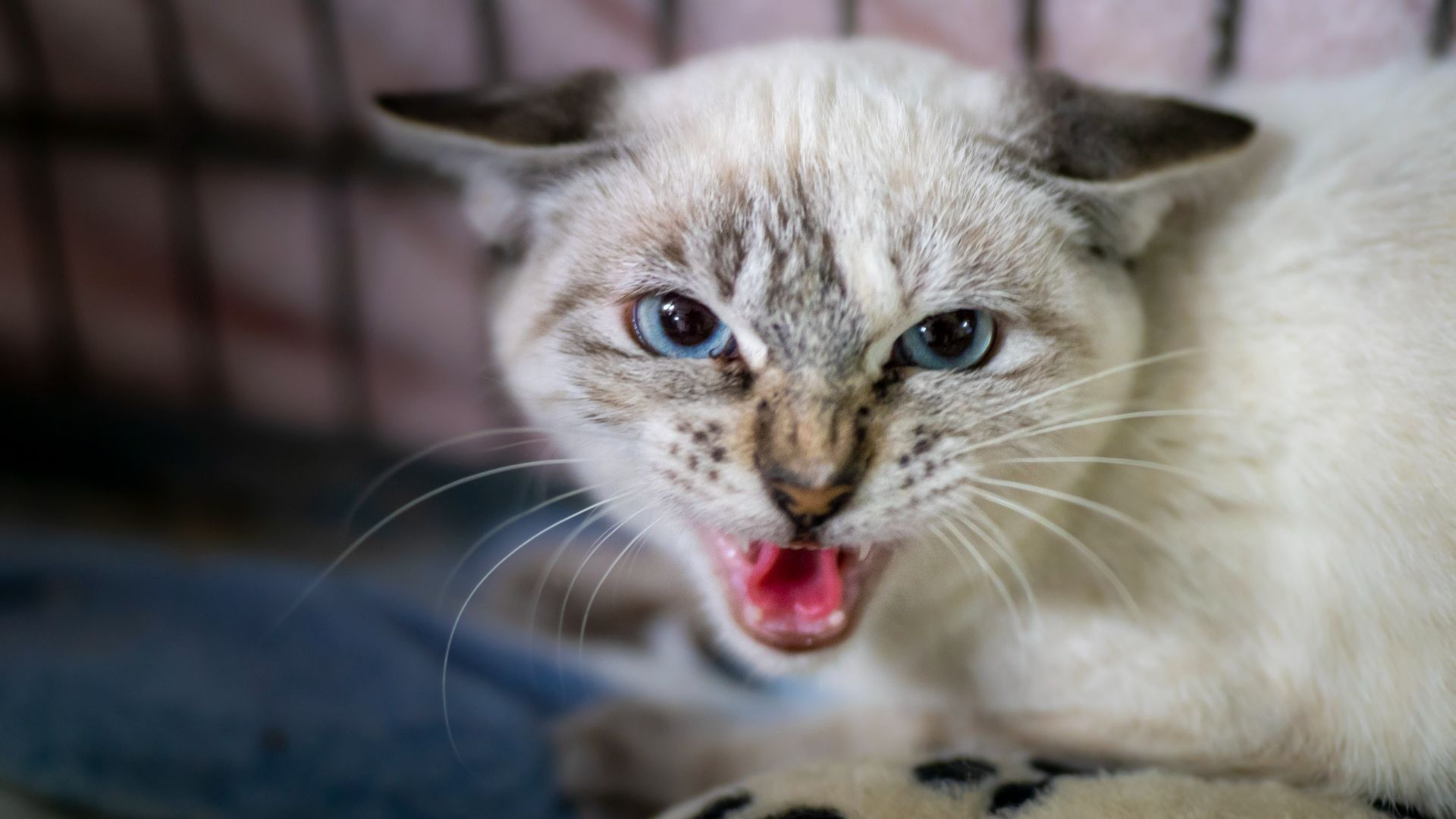How to put a stop to cat play aggression
Want to stop cat play aggression? Our vet has the solution

Cat play aggression is a problem that lots of pet parents face – but the solution isn’t as complicated as you might think. Things like the best cat toys, scratching posts, and feline furniture are important for enrichment and can help reduce feelings of frustration and boredom that lead to aggression.
This common cat behavior problem is perhaps one of the most confusing – one minute you’re enjoying a fun playtime session, and the next, they’re sinking their claws and teeth into your arm!
As strange as this might seem, there are a few things that could be causing it, like a lack of socialization, which vet Dr. Rebecca MacMillan has explained below. Thankfully, it’s not something you have to live with forever, as there are a number of ways to fix this behavior.
What causes cat play aggression?
What is perhaps surprising is that, most of the time, your cat may be as good as gold. There's no hint that they're being necessarily territorial or feeling threatened and they are, to all intents and purposes, happy.
The mayhem – the hissing, biting and clawing – is only happening when you play. But why is this? In some cases, it's simply because a cat is under-stimulated which is why you should always consider buying the best interactive cat toys.
Sometimes, a cat is merely acting naturally, with studies showing that cat play can be a way for felines to practice predatory instincts. In fact, play aggression could be a cat's way of learning some boundaries – by nature, a cat will test how far it can go with other cats to establish a hierarchy and your pet is likely doing the same with you.
It's why play aggression is more typical of cats under the age of two. They're undergoing a process of education which is why a cat's upbringing plays a big part.
Cats that were weaned or removed from their littermates too early tend not to grow up understanding the difference between play and predatory behavior. What's more, how you interact with a kitten or young adult cat can also have a massive affect on play aggression. In many cases, cats simply don't know any better.
Dr. MacMillan says: "Play aggression in cats can often be caused by a lack of social interactions when they were very young. If your cat was not raised with their littermates, and didn’t have much opportunity to play, they will have missed out on a key part of their socialization. Playing with fellow kittens allows them to test the boundaries and learn when they might be biting or scratching too hard."
You might want to read our guide on how to play with a kitten.

Should you play rough with cats?
With that in mind, it's important to know how to play with a cat. For starters, you should avoid using your hands, feet or other body parts as a toy because that could lead a feline to play-hunt with you. Instead, your hands should only ever be used to stroke, hold and gently pet your cat – and only at times when your moggy appears to be calm.
One thing's for sure, rough play can easily fool a cat into thinking that it's absolutely fine to bite or scratch at your flesh. And while a kitten's playful bite isn't much of an issue, if this kind of behavior continues into adulthood, then it suddenly becomes a painful problem.
Rough play also changes the dynamic of your relationship with a cat. You may think it's a heap of fun to wrestle with a cat but felines don't like it, especially if it makes them feel vulnerable or causes them to be pinned down and trapped.
A moggy will go on the defensive in a situation like that and play times will end up as a free-for-all. Cats will also start to see all humans as a potential rough playmate which adds a whole layer of extra issues. Better to try one of these fun games to play with cats instead and keep playing gentle and calm.
Dr. MacMillan says: "I always advise cat owners not to play rough with their pets. It sends out the wrong messages to your cat. Rough play can easily stray into aggressive behavior. This could lead to you becoming injured and your cat becoming confused by the whole situation.
"While rough play might seem fun with a very young kitten, adult-sized teeth and claws are not to be messed with. It is therefore important to start as you mean to go on with a consistent message about what type of play is appropriate. Fingers must never be used as toys; they are for stroking and fussing your pet only."
Do cats grow out of play aggression?
Many cats will eventually learn that play aggression is wrong and undesirable. By adulthood they may well have learned how to hunt and fight (more so if there are other cats around either in your home or outside) and they'll have figured the necessary boundaries between play and reality.
Some, however, don't grow out of it. They've become excited by your hands and feet and they still don't understand that you don't want them to stop scratching or biting (which is why they will sometimes cling on tightly to you). How you've responded to that in the past will make a huge difference. If, as a kitten, you've laughed it off and indulged in such play, then you will find it more likely that play aggression will be ongoing.
Dr. MacMillan says: "Aggressive play is most commonly seen in kittens and young cats. Most will mature and grow out of it, but this will only happen if you help your cat learn what type of play is appropriate."

How do you fix play aggression in cats?
There are numerous measures you can take to prevent play aggression (and some things you should never do).
1. Recognize the signs of aggression
Dr. MacMillan says: "First, it’s important to recognize when a cat is about to become aggressive in their play. They will usually thrash their tail around, pin their ears back, and have wide, dilated pupils. They often start stalking you or your family members, getting ready to suddenly pounce from a hidden position. Other pets can also be a target."
Frisco Fabric Teaser Wand Cat Toy | Chewy
If your cat gets aggressive during playtime, we recommend the Frisco Teaser Wand, which keeps your hands out of claws' reach. Our tester, Julie, says it’s great for interactive play, and unlike other toys, you won’t have to get hurt in the process!
2. Spot the pattern
Dr. MacMillan says: "Sometimes there is a pattern to this behavior, and it is possible to predict when it will occur. It could be at a certain time of day or in a certain location of the house, for example, your cat might always pounce at you from behind the sofa.
"If you can work this out, you can then take steps to stop the aggression before it even starts. Try blocking key hiding areas or stopping them from accessing the room where aggressive play frequently occurs. If the pattern of behavior is not clear, you could consider putting a collar with a bell on your pet so that you can hear them coming."
3. Positive interactions
Dr. MacMillan says: "You must focus on plenty of positive interactions with your cat. Don’t be afraid to engage in play but do it on your terms. Try and have a set time of the day so that your cat knows when to expect their play sessions. Using toys that you can keep at arm’s length like fishing rod ones or a feather on a stick will help to keep your fingers out of the firing line."
4. Stop the game
Dr. MacMillan says: "If your cat starts becoming over the top in their play, you should stop the game, issue a calm ‘no’, and then quietly leave the room to a safe space. Your cat will soon learn that aggressive behavior is not tolerated and leads to them being ignored, which is boring.
"If your cat attacks you at random then carrying a small toy in your pocket can be helpful. You can throw this away from you to distract your cat and encourage them to play with something other than your ankles!"
5. Never punish your cat
Dr. MacMillan says: "While this behavior can be challenging, you must never punish or scare them as this could make their aggressive tendencies worse. It could also make your cat fearful of you, leading to a deterioration in your relationship.
"You should also make sure that your cat’s needs are being met in their home environment. This includes plenty of enrichment in the form of toys, scratching posts, and other cat furniture, to stop your cat from becoming bored or frustrated."
6. Speak to your vet
Dr. MacMillan says: "If you are struggling with your cat’s behavior, then don’t hesitate to speak to your vet or a qualified pet behaviorist. It is far between to get help than it is to continue struggling with the situation."
Wondering whether you should let your cat play with yarn? This feature has the answer. Or, read about your cat's play personality,
Edited by Georgia Guerin and Alexis de Leaver.
Recent updates
This page was last updated on March 7 by Megan Milstead.

Rebecca is a veterinary surgeon who graduated in 2009 from the Royal Veterinary College in London. She has a wealth of experience in first opinion small animal practice, having done a mixture of day-to-day routine work, on-call emergency duties and managerial roles over the years. Rebecca enjoys medicine in particular and she is proud to have recently achieved a BSAVA postgraduate certificate in small animal medicine (with commendation).
PetsRadar Newsletter
Get the best advice, tips and top tech for your beloved Pets

David Crookes has been a journalist for almost 30 years and he has written for a host of magazines, newspapers, websites and books including the World of Animals Annual, BBC Earth, Live Science, The Independent and Tom’s Guide.
Born in England, he lives with two cats but he’s also keenly interested in the differences between the huge number of dog breeds – in fact, you can read many of his breed guides that he’s written in collaboration with vets here on PetsRadar.
With a lifelong passion for technology, too, he’s always on the lookout for useful devices that will allow people to keep their pets happier and healthier, and provide them more time to spend together.
David has a degree from Durham University, as well as postgraduate diploma in journalism from the University of Central Lancashire.
- Dr Rebecca MacMillanVet
- Megan MilsteadStaff Writer

